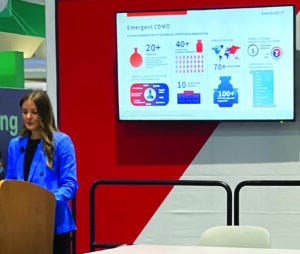- Sponsored Content
Using Innovation and Investments to Advance Nanoparticle FormulationsUsing Innovation and Investments to Advance Nanoparticle Formulations
August 24, 2022
Sponsored by Emergent BioSolutions
 Tara Lorenz, director of commercial development, Emergent BioSolutions.
Tara Lorenz, director of commercial development, Emergent BioSolutions.
Lorenz presented two case studies: one demonstrating technology transfer of a liposomal immunotherapy using extrusion technology and the other describing process performance qualification (PPQ) of a lipid nanoparticle (LNP) formulation for mRNA delivery. The first example product is a self-assembling, protein-based nanoparticle vaccine that’s now in phase 1 clinical testing. The second project involves peptide–mRNA nanoparticle therapeutics against specific cancer targets.
Emergent operates three centers of excellence for nanoparticle-based formulations, each with unique offerings in formulation development, lyophilization, large-scale lipid-based formulations, and so on. “Although nanoparticle formulations have gained attention recently,” she said, “our team has been supporting liposomes and lipid-based formulations for over two decades.” The company continually assesses new technology for scalable continuous processing of lipid nanoparticles. Emergent has invested recently in microfluidics with specialized gear pumps and nanoparticle tracking analysis (e.g., for particle identification, size distribution, and concentration). The company also expanded a good manufacturing practice (GMP) cleanroom area to support large-scale lipid-based formulation work. That required engineering controls for handling large volumes of ethanol solvent and an automated visual-inspection system. Emergent also has invested in fill–finish lines including an integrated autolyophilizer.
In the first case study, the challenge was to scale up a legacy process to work with new extrusion technology. Basically, peptides and lipids are mixed and then extruded to produce liposomes of appropriate size, followed by sterile filtration, filling, and lyophilization. Emergent had to transfer that technology from a laboratory-scale to a new manufacturing-scale extruder. To save time, that work began in parallel with factory- and site-acceptance testing of the equipment.
Challenges arose related to lipid hydration and liposome formation and sizing. The temperature-sensitive mixture was a malleable, waxy solid. “We needed to ensure full hydration at the intended concentration and establish the lipid hydration endpoint,” Lorenz said. “This operationally complex, high-pressure extrusion process had a requirement for continuous recirculation and in-process monitoring of key parameters.” Those parameters were defined at laboratory scale, then confirmed at manufacturing scale.
The team optimized lipid hydration time at small scale, then designed studies to evaluate particle size and identify an optimal extrusion-membrane pore size. Feasibility runs helped to define extrusion parameters, determine optimal flow rates within required pressure limits, set pH targets to minimize in-process adjustments, and so on. Other challenges arose for equipment validation, cleanability, pump changes, and lyophilization cycling. For process verification at 6-L scale, Emergent collected bulk drug-product samples to justify hold times and assess material loss throughout the process.
In the second case study, Emergent helped a client adapt its mRNA-based COVID-19 vaccine to cancer treatments for clinical testing. Making the drug product entails mixing lipids and mRNA, followed by tangential-flow filtration (TFF) using hollow-fiber membranes, then sterile filtration and filling. Emergent developed and scaled up an in-line mixing approach, executing laboratory- and manufacturing-scale work in parallel to minimize the timeline to biologics license application (BLA) submission.
The path to process validation included characterization work to define the critical process parameters (CPPs) and ensure consistency in meeting product quality attributes (PQAs). “We’re mindful to understand the impact of parameter variations,” Lorenz said, so that those can be controlled based on risk assessment. The methodology includes joint data review with clients to finalize study designs before moving forward. In this case, a scale-down model was important to the particle-formation aspect while working with limited mRNA material.
Lorenz said her team worked to ensure that the scale-down model incorporated identical mixing geometry, flow rate, and pressure control using using representative mixing equipment. After verifying its robustness, the team used that model for a design-of-experiments (DoE) particle-formation study, then generated mRNA LNP material for TFF.
TFF optimization work was ongoing when Lorenz gave this presentation. The team is using RiboGreen-assay, light-scattering, and high-performance liquid chromatography (HPLC) analytical methods. So far, the mRNA process has been scaled up to 50×, with facility construction, automation, upgrades, and so on — performed in parallel to support the space requirements of PPQ batches later in 2022.
Fill out the form below to view the full BPI Theater presentation.
You May Also Like






